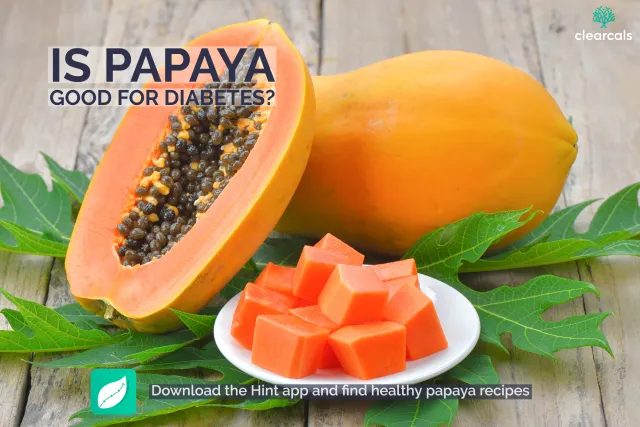Looking for a Personalized Diet Plan?
Is Papaya Good For Diabetes?

TLDR
- Papaya is a good source of fiber and hence does not raise blood sugar levels as it slows down the absorption of sugar in the bloodstream.
- Papaya is a good source of vitamin C and Vitamin A and helps in improving immunity.
- There is limited scientific evidence to support that papaya fruit pulp is good for diabetes.
- To benefit from various nutrients in papaya, eat it in moderation and prevent blood sugar spikes.
Papaya, also known as pawpaw or papaw, is a tropical fruit that is native to the Americas. It is a common ingredient in many dishes and is known for its sweet and juicy taste.
In addition to its delicious flavor, papaya has also been touted as a possible aid for individuals with diabetes.
Let’s explore the available scientific evidence behind this claim.

Papaya Calories 100g
One small cup (100 grams) of papaya contains 22 kcal. 85% of these calories are from carbohydrates, 7% are from protein, and 8% are from fat. Papaya is a good source of biotin and an excellent source of selenium, vitamin C, and vitamin D. It is low in calories and contains an adequate amount of dietary fiber.
Benefits of Papaya

1. Helps treat constipation, indigestion, and bloating
Papaya is a good source of both soluble and insoluble fiber, with one cup of papaya containing around 2.8 g of fiber, nearly 10% of the recommended daily intake of dietary fiber.
Since papaya is a good source of fiber, it helps manage constipation. Results from a double-blind placebo-controlled clinical study suggest that papaya extract (Caricol) helps treat indigestion and symptoms like constipation, bloating, and heartburn1.
2. Rich in antioxidants
Papaya is also rich in antioxidants and other nutrients that may be beneficial for individuals with diabetes. It is a good source of vitamin C, which is important for maintaining healthy blood vessels and protecting against oxidative stress.
3. High in vitamin A
It is also a good source of vitamin A, as it contains carotene and lycopene which is important for maintaining healthy eyesight and immune function and reducing the incidence of vitamin A deficiency2.
4. Lowers blood pressure
Additionally, papaya is a good source of potassium, magnesium, folate, and vitamins like vitamin A, C, E, and B complex vitamins, which are important for maintaining healthy blood pressure and preventing cardiovascular diseases3.
Glycemic Index Of Papaya
The glycemic index is a measure of how quickly a food raises blood sugar levels. Foods with high GI ratings are more likely to cause a rapid increase in blood sugar, while foods with a low GI rating are less likely to cause a rapid increase.
Papaya has a GI rating of around 60, which is considered moderate4.
This means that it is less likely to cause a rapid increase in blood sugar levels because of moderate level GI and high fiber content, making it a safe choice for individuals with diabetes.
Papaya for Diabetes
Several animal studies have suggested that papaya seed and leaf extract have potential benefits for individuals with diabetes.
According to a study, it was found that papaya leaf extract was able to lower blood sugar levels in mice with diabetes. It also decreased cholesterol levels, improving the lipid profile of diabetic rats5.
Another study concluded that papaya leaf extract can be used as a drug for managing diabetes as it lowers blood sugar levels and lipid profiles in diabetic rats6.
However, it’s important to remember that these studies were conducted on animals and do not directly include papaya fruit pulp, so it’s not clear if the same effects would be seen in humans eating papaya.
Thus, we conclude that the results of these studies are preliminary and more research is needed to determine if papaya fruit is truly effective for individuals with diabetes.
Conclusion
Based on the nutrition information of edible papaya fruit, we recommend that papaya can be included in moderate quantities in the diet of diabetic people as it is a good source of fiber, low in calories, rich in micronutrients, and also has a glycemic index of 60, which is moderate.
Nonetheless, despite its potential benefits, it's important to remember that papaya should not be used as a sole treatment for Diabetes.
Managing diabetes requires a combination of lifestyle changes, such as eating a healthy diet, getting regular exercise, and taking medications as prescribed.
Using the Hint app you can change your lifestyle by improving your eating habits and physical activity level.
Are you looking for guidance in following a diabetic diet?
Download the HINT app and subscribe to the instant diabetic diet plan. It helps you control your blood glucose levels and reduces your HbA1c in a few months.





